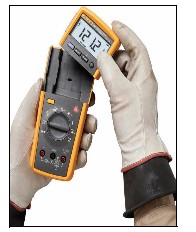
This special story attempts
to capture the current
trends in the testing &
measuring equipment
industry. The T&M industry
has never got its due
importance for a host of
legacy reasons. Attitudes
towards the industry are
now changing for the
better, and so is the
outlook for this niche
segment, notes
Venugopal Pillai.
The test and measure (T&M) industry in India is still in
its budding stage. The industry size is nowhere close
to its true potential, and hence presents huge growth
opportunity to its players. In a wide sense, T&M equipment
is used for a variety of applications, mainly including
education, routine maintenance and monitoring, research &
development, manufacturing, and calibration. The sectors
to which T&M is relevant are diverse—ranging from simple
equipment used in educational laboratories to high-end
space research.
When we look at T&M in the power sector, we are
speaking of a gamut of equipment and services used
spanning the entire power chain—right from a power
generation plant up to the final consumption of electricity.
Even here, T&M is used at both stages-during construction
of the asset and in its regular operation.
A vital segment of the power-related T&M industry is
equipment used in the transmission and distribution
segments. This involves a variety of instruments used to
test and measure the efficiency of power supply and
consumption. The instruments can include simple hand held
devices to sophisticated permanently-installed
monitors. The size of this industry is estimated at around
`700 crore and experts feel that, given the right thrust,
annual growth of around 10 per cent can be easily achieved
in the medium term.

The Indian power T&M equipment industry has
distinctive segmentation. When it comes to common
measuring devices like meters, there are several players with
a predominance of the SME sector. As one moves higher on
equipment-sophistication levels, the number of domestic
players shrinks greatly and there is a marked reliance on imported equipment. In terms of advanced T&M
equipment, there are very few players with 1962-
incorporated Aplab Ltd widely regarded as the domestic
market leader. Multinational players like Fluke, Agilent,
Tektronix, Giga-tronics, Amtek, Exctech Electronics,
Voltech Instruments, etc have a presence in India through
their representative offices and channel partners.
What is calibration? |
 Aset of operations, performed in
accordance with a definite
procedure, which compares the
measurements performed by an
instrument to those made by a more
accurate instrument or a standard for
the purpose of detecting and
reporting, or by adjustment, errors
met in the instrument tested. (Source: Shriram Institute for
Industrial Research) Aset of operations, performed in
accordance with a definite
procedure, which compares the
measurements performed by an
instrument to those made by a more
accurate instrument or a standard for
the purpose of detecting and
reporting, or by adjustment, errors
met in the instrument tested. (Source: Shriram Institute for
Industrial Research) |
Industry players point to a growing presence of Chinese
equipment, largely coming from dumping of second-grade
instruments. The market is flooded with low-cost testing
instruments that barely pass the muster. It is also believed
that non-availability of updated industry standardization
and the non-enforcement of existing standards is indirectly
encouraging the import and sale of substandard and noncompliant
equipment. It is not only China but even other
countries continue to treat India as a dump yard for inferior
T&M equipment. An industry player also brought to the
light the growing tendency of small and tiny Indian
manufacturers preferring to deal in imported Chinese
equipment instead of manufacturing their own. Regardless
of quality, Chinese competition is almost invincible on the
pricing front.
There are also tax-related disparities that work against
domestic manufacturers. Most T&D products attract zero
customs duty. Importers pay only countervailing duty. On
the other hand, if the product is manufactured in the
country, key raw materials need to be imported on which
customs duty as well as CVD needs to be paid. Local
manufacturers therefore tend to lose the cost advantage, an
industry player pointed out.
Poor base: The biggest reason of why the power-related
T&M industry in India is still in a fledgling state is perhaps
a non-conducive deployment arena. As a culture, research &
development (R&D) in the power sector has always taken a
backseat. Secondly, India seriously lacks testing facilities.
This inhibits the growth of the T&M equipment industry.
One more factor is that the Indian power sector has never
embraced the culture of regular monitoring of critical
equipment in the power chain. An industry expert
explained that the power chain — from generation to
consumption — has a plethora of equipment. Efficiency in
the power chain can be brought about if the equipment in
the chain is in optimum condition. Periodic checks on the
health of the equipment can prevent breakdowns and
ensure that quality power is delivered. Routine checks can
boost the T&M industry, apart from keep the power chain
efficient, at all times. This is seldom practised in India, the
expert noted.
R&D is not a popular choice of profession and the
government must encourage the younger generation to
considering power-sector R&D as a career choice. While
developed countries have contributed by way of innovative
T&M equipment, it is still early days for India.
Calibration: One of the key determinants of the growth
of the T&M market is strict enforcement of calibration and
testing norms. In India, calibration facilities are perceived
to be inadequate, at least at the moment. More importantly,
the awareness of proper calibration and even testing is low.
Calibration, in simple terms, is the process by which a given
testing instrument's performance is compared with that of
a standard instrument. This ensures that readings of the
instrument are accurate and trustworthy. It is observed
that over a period of time, the readings of T&M instruments
may vary. Periodic calibration is necessary to ensure
optimum performance of the instrument.
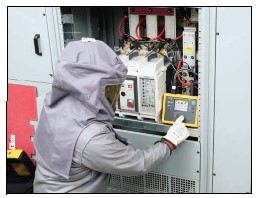
Even though facilities for testing and calibration in India
are lesser developed than in developed or even developing
countries, experts feel that there has been perceptible
growth in recent years. Once stringent and unbiased norms
for testing and calibration are enforced in India, rapidity in
the growth of the Indian T&M market is assured.
What is Smart Grid? |
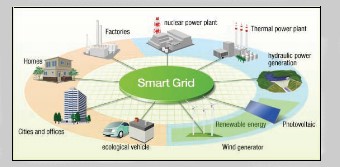 A Smart Grid is an emerging phenomenon, currently in vogue only
in highly developed nations. Although there is no standard
definition of the term, it is seen as an assembly of hardware,
computer software and IT-based solutions that aim to bring about
energy efficiency in a power distribution network. A Smart Grid aims
to optimize energy efficiency by reducing energy delivery losses
and balancing load in order to minimize peak transmission
requirements and grid redundancy. It is very interesting to note that
while there has been a big leap in the technology used for building
power generation plants, there is no radical difference in the way
power distribution networks have been built around the world, over
the past century! A Smart Grid attempts to provide a real-time
picture of system conditions so that there is more meaningful
control over the power distribution process. Today, in most cases,
power utilities do not have a real time picture of the system
conditions. This is the biggest challenge. It forces utilities to be
reactive, which is taking remedial action after some damage has
occurred, rather than proactive, which is being able to forestall the
damage by taking preventive action. For instance, the most
common aberration in a power distribution network—power
outages—are known to power utilities only after they are reported.
A concept note by "BPL Global" explains that the key objectives of a
typical Smart Grid would involve digital real-time monitoring and
control of the power distribution network, integrating
communications, transforming the energy meter into a two-way
portal between the consumer and the power utility, and integrating
distributed energy resources. |
Energy efficiency: India's electricity chain is
generally inefficient, seen from many angles.
Infrastructure for transmission and distribution has not
kept pace with new generation capacity. This results in
acute shortages and region-wise disparities. This is only
part of the problem. The bigger problem is that power
supplied to most places is interrupted and unclean.
Uninterrupted and clean power is today seen only in
highly-developed urban pockets. Experts feel that
increased use of T&M equipment could result in
improving at least the quality of power supplied. Right
from the power generation plant to the final distribution
substation, there is a plethora of equipment used. Periodic
testing and preventive maintenance of this could boost
the use of T&M equipment.
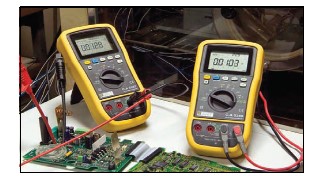
Even on the consumption side, much of the power
consumed is done so inefficiently. By and large, industrial
consumers fail to maintain a high power factor ratio. It is
encouraging to note that power distribution utilities are
imposing penalties on consumers that consistently fail to
ensure efficient power consumption, which is measured by a quantifiable power factor ratio. Instruments used to
manufacture power factor ratio can play a vital role in
assessing this situation.
FUTURE READING
The future for the Indian T&M equipment industry is
certainly very bright. This optimism essentially comes from
the country's power sector ambitions. India is set to add
around 15,000 mw of new power generation capacity per
year, over the next 5-7 years. New power generation plants
and supporting evacuation infrastructure will positively
influence prospects of the T&M equipment industry. It is
also pertinent to note that Indian power transmission is
moving to the EHV and UHVAC class, which will generate
demand for even more sophisticated equipment.
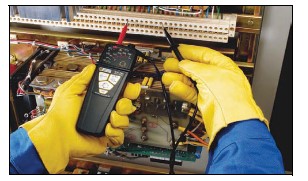
The use of T&M equipment is two-fold. The first
application is the construction stage, which is when power
generation and T&D infrastructure is physically built. The
second important application is to ensure that power
infrastructure operates at optimum levels. By 2012, at least
as per targets, India's power generation capacity is expected
to touch 2 lakh mw, nearly doubling over the past decade.
Hence, the power network will get increasingly intricate.
Industry experts say that the future of the T&M
equipment industry lies in real time and remote
monitoring. This is in contrast with current trends that are
identified by equipment-driven and local testing. Hence,
the future trend will be towards computerized data
acquisition, processing and analysis. Computer software
and Internet (IP) based applications will be a big component
of the T&M industry, as we go forward. According to Joey
Joseph, Managing Director, TTL Technologies Pvt Ltd, "PCbased
software that can do advanced analysis and archiving
of data is now common in all new-generation test
instruments." Power quality monitoring and recording
systems are typical examples of web-based applications.
A mature power sector is characterized by the availability
of quality power, on a continuous basis. The T&M industry
will hence aim at helping achieve just this. In an extended
sense, the concept of Smart Grid is essentially a very
intelligent and sophisticated form of testing and
measurement of the entire power chain.
Time-tested Views |
We have to depend fully on imports. Sometimes this becomes a
major hurdle in the development of sophisticated products.
Aplab has so far managed to make indigenous products which remain
an economical substitute for imports, but we know how difficult it
becomes to bridge the gap in technology covered by countries in the
West and the Far-East.
Ms Neelam Kumar, Executive Director, Aplab Ltd
We agree that power sector has given a little bit less emphasis on
having quality T&M equipment. But the scenario is changing
fast with new regulations regarding efficiency, safety and reliability
coming in. This has increased the accountability of people in
business. We expect to have greater penetration of T&M equipment
in the power sector in future.
Suneel Kapoor, General Manager, Industrial Group India, Fluke
State-of-art technology, high reliability and conformance to the
latest international test standards have traditionally been a driver
for Indian customers to look beyond Indian brands. Foreign brands
tend to offer attributes like portability and ruggedness into their
product design and packaging that appeal to Indian customers.
Joey Joseph, CEO & MD, TTL Technologies Pvt Ltd
Some companies in India don't give much importance to R&D as
well as maintenance and re-calibration of the T&M equipment.
This has resulted in lower demand. Probably if companies give more
focus on R&D and on regular maintenance of their plants, demand will
increase.
S. Mahendra Bothra, Managing Director, Microtek Instruments Ltd
(Views are based on exclusive interactions with Electrical Monitor. Full
interviews are presented elsewhere in this edition.)
|